Day Trading Forex Futures with Pivot Points
By Eric Utley
TradingMarkets.com
Currency trading is increasing in
popularity among individual investors, especially those in the
United States. Just a few short years ago, it was relatively
difficult and costly to access the spot Forex market. But
barriers have been broken down, competition has increased, and
costs have fallen. As a result, more and more retail traders are
entering the realm of spot Forex trading.
But there's another way to enter the world of currency trading,
and it's through the Chicago Mercantile Exchange (CME). The CME
first offered Foreign Exchange (FX) futures in 1972. Today, the
exchange offers futures on 41 currency pairs, options on 31
futures contracts, and over $60 billion in liquidity. Currency
futures trade on the CME's renowned Globex platform, alongside
other popular futures contracts such as the e-mini equity
indices.
Spot vs. Futures
To be sure, there are a some big differences between
the contracts that trade in the spot Forex market and the FX
futures. Perhaps the biggest -- and arguably most important --
difference is that spot Forex contracts trade over the counter
at no particular central location, while FX futures clear at the
CME. The central clearing and guarantee of counterparty
credit by the CME are huge benefits of FX futures over spot
Forex contracts.
The dealing details differ dramatically between the two
instruments. The table below details some of the biggest
differences:
Over-the-counter (Spot,
Forex) Foreign Exchange Futures
$2+ trillion daily turnover $60 billion in liquidity
Commission free Commissions
Guaranteed stops No guarantees
Fixed pip spread Bid/Ask spread
24 hour trading 23 hour trading
100:1 up to 400:1 leverage 20:1 to 50:1 leverage
Varying quote currencies All rates quoted in dollars
Plain vanilla & Exotic options Plain vanilla options
Mini accounts Mini contracts (limited)
Interest debits & credits Carrying costs
Automatic rollover 3 month expiration cycle
Personal Preference
Whether you trade spot contracts or futures on
currencies will depend upon your own risk tolerance, equity, and
other needs. I've traded spot, through several different
dealers, and the futures for many years. I continue to use both
instruments in varying situations, alternating my selection to
fit different strategies.
I like to use the spot contracts when executing very short-term
strategies, such as a straddle surrounding a high profile
economic announcement or central bank meeting. For example, I
would use the EUR/USD spot contract to execute a trade during a
Federal Reserve announcement or Non-farm payrolls release. Or I
would use the USD/JPY spot contract to trade a Bank of Japan
meeting. The guaranteed stops that some spot Forex dealers offer
are very useful when trading around a volatile announcement like
a central bank meeting.
Additionally, I favor the spot contracts when trading
cross rates -- the exchange rates that exclude the U.S. dollar;
for example: EUR/JPY, GBP/CHF, AUD/NZD, and GBP/HUF.
Cross rates can be an excellent tool to take advantage
of varying degrees of relative strength in individual
currencies. And they are a great way to trade the currency
market when the majors are at an equilibrium (read: trading
range). You can find tremendous trends in the cross rates, and
you can find hundreds of cross rates at many spot Forex dealers.
On the other hand, futures on cross rates are comparatively
illiquid and limited.
But for the most part, I trade the currency futures. That's
because the cost of trading futures is, in most cases, lower
than trading spot Forex. I've found futures cost about $20, or
less, per round turn, while the spot Forex contracts cost
between $30 to $50, and up, per round turn. The lower cost of
trading currency futures is why I use the instrument in all of
my day trading strategies, including the pivot point
methodology.
(But please know that you can apply spot Forex
contracts to the methodology that I'm about to show you.)
Pivot Points
Pivot points are a popular tool used by futures traders
in all sorts of markets, ranging from equity indices to crude
oil. And, sure enough, pivot points are readily applied to
trading currency futures.
Pivot points are support and resistance levels derived
from the previous period's high, low, and closing values.
There are a variety of pivot values with which to
trade, including monthly, weekly, and daily values. You could
even calculate hourly values. When determining which period to
trade with, you've got to consider your time frame as an
individual and your particular style. I'll use daily pivot
points for the purpose of this article since the focus is day
trading.
Daily pivot points give a structure to each new trading day in
the currency market. With these values you can use traditional
support and resistance techniques to enter and exit trades. But
before I get to the strategy, I'll show you how to calculate
pivot values.
Pivot Point (PP) =
(High + Low + Close) / 3
Resistance 1 (R1) = (2 x Pivot Point) - Low
Support 1 (S1) = (2 x Pivot Point) - High
Resistance 2 (R2) = Pivot Point + (Resistance 1 - Support 1)
Support 2 (S2) = Pivot Point - (Resistance 1 - Support 1)
(Pivot values for several different currency pairs are
posted on the TradingMarkets web site every day.)
The pivot values are plotted as horizontal levels
which, in turn, serve as support and resistance. The pivot point
itself can be thought of as the day's mid-point, or fulcrum.
It's where the buyers and sellers meet to determine the day's
trend in a currency pair. The support and resistance levels that
are plotted around the pivot point are just that: potential
support and resistance.
A daily pivot point (in green), S2, S1, R1, and R2
values are plotted on the chart below of the EUR/USD FX future.
The chart is a 5-minute interval. Notice how the Euro broke
above the pivot point early in the day, and then proceeded to
trade up to R1, where it met resistance and gyrated for the rest
of the day.
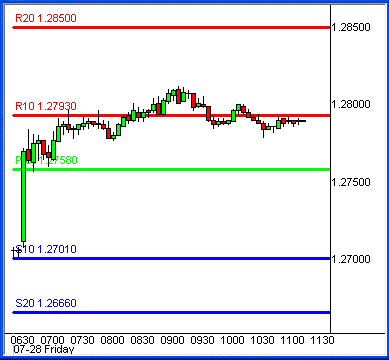
Source: Quote.com
Follow The Intraday Trend
The power of pivot
points is unleashed when you follow an unfolding trend during
the day, and use the pivot values to measure the magnitude of
trend. Additionally, the pivot points can be used to determine
entry points into a trade. Applying simple breakout and
breakdown entries around pivot points is a powerful way of using
the tool.
An example of following the trend of the day as it
unfolds, and entering trades on the break of pivot values, is
illustrated on the 5-minute chart below of the JPY/USD contract.
In this example, the Yen began the day near its pivot
value, rolled over from R1, and proceeded to breakdown below the
pivot point, S1, and S2. The pair dropped by about 60 ticks,
providing ample opportunity for a day trader to make money on
each breakdown below support. These types of intraday trends
unfold a few times throughout the trading week, and they are
relatively easy to exploit by following the futures contract
through its pivot values.
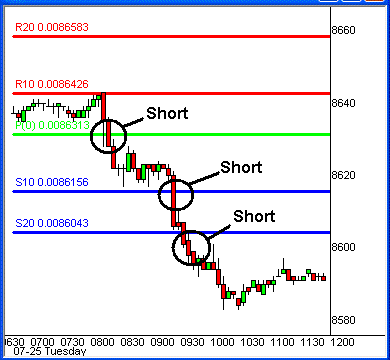
Source:
Quote.com
A second way of leveraging the power of pivots in the
currency futures market is by adding a technical indicator that
can pinpoint buy and sell signals. You will
still want to use traditional support and resistance techniques
around the pivot values. The purpose of adding
to the indicator is to help in the timing of an entry into a
trade. Above all else, though, you want to trade in the
direction of the unfolding trend.
The MACD (12,26,9) is added to the 5-minute Euro chart
below. The MACD generates simple buy and sell
signals with the crossing of the fast and slow lines. Quite
simply, it's time to buy when the fast line crosses above the
slow. Conversely, it's time to sell when the fast line crosses
below the slow line. Only the buy signals are
highlighted on the chart below because the Euro was in an upward
trend during the day. The sell signals are ignored due to the
upward trend in the contract.
The Euro began the day at 1.2640 and ended near 1.2740
for a move of roughly 100 ticks. That's a lot of potential
profit, part of which could have been captured by simply
following the trend of the day and taking the buy signals coming
from the MACD.
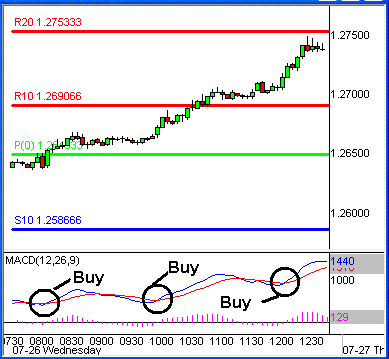
Source:
Quote.com
Pivot Point Tips And Tricks
Trading with pivot points is not a big secret. Floor
traders and dealing desks have been applying the methodology for
decades in the currency market. But what
separates the
profitable traders from the losers is the simple act of
following the trend of the day, cutting losses short, and
letting profits run to the next pivot value. In
addition, there are a few observations I've made over the years
that I can add to the simple truth of following the trend.
The first tip I want to share is that the best trend
days usually unfold when the currency begins the trading day
near its pivot point. You might have already made this
observation in the two above examples of the Euro and Yen.
If you didn't, then take a second and jump back to the
above charts, and note how the Euro and Yen began the day at or
very near their pivot points. There are usually two or three
days out of the week during which the majors such as the Euro,
Yen, Pound, and Franc begin trading at their daily pivot. These
are the days to look for a big trend to unfold.
If the currency that you're trading begins the day far
away from the pivot, either below S2 or above R2, then it's
probably a day that you want to walk away from. When a currency
opens the day at one of the daily pivot extremes, it usually
spends the rest of the session gyrating around that level. Avoid
trying to trade a reversal of the overnight trend. Occasionally
it might occur, but more often than not a big overnight trend
will stall out at R2 or S2. The temptation is there to try to
squeeze out a small profit, or bet on a reversal of the
overnight trend. But the reality is that these are the days that
can destroy a trader's equity.
You will find two examples below of strong overnight
trends leading to massive gaps at the open of New York trading
in the futures market. The first is an example of a gap up in
the Euro. The pair opened at R2, where it spent the rest of the
session. The second example is of a gap down in the Pound.
The contract opened below S2, and spent the rest of the
day gyrating in a tight range.
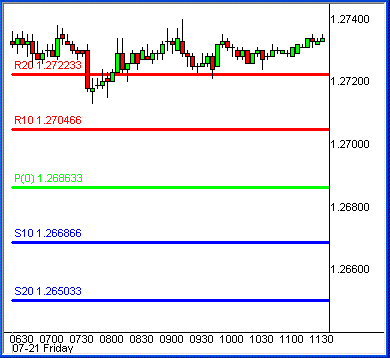
Source:
Quote.com
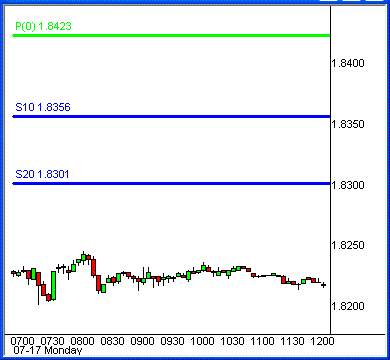
Source: Quote.com
These days are best left to the
floor traders. In the long run, you'll be better off not even
trying to trade during days when the currency futures stage a
substantial gap, either high or lower. You'll be better of by
waiting for those days when the currency futures open near their
pivot points.
Profit With Pivots
Day trading with pivot points can be applied to the
spot Forex market just as they are in the currency futures
market. Support and resistance, and the techniques that
accompany these price levels, are consistent across all markets.
In fact, pivot points have been used across dealing desks for
decades in the spot Forex market. To the individual investor,
however, it makes more sense to use currency futures when day
trading simply because of the lower costs associated with
trading futures.
The most important point to remember when applying pivot points
to day trading currency futures is to follow the trend of the
day, and simply look to enter into an unfolding trend as a pair
makes its way through pivot values. Pay special attention to
those days when the currency opens at or very near its pivot
point. And avoid trading when a contract opens far away from its
pivot point, at or beyond S2 and R2 values.
Good luck!
|




